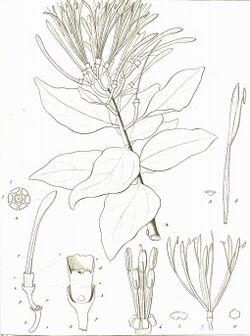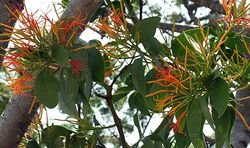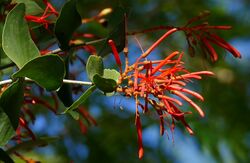Biology:Psittacanthus calyculatus
| Psittacanthus calyculatus | |
|---|---|

| |
| Psittacanthus calyculatus in de Candolle in 1830 | |

| |
| Psittacanthus calyculatus | |
| Scientific classification | |
| Kingdom: | Plantae |
| Clade: | Tracheophytes |
| Clade: | Angiosperms |
| Clade: | Eudicots |
| Order: | Santalales |
| Family: | Loranthaceae |
| Genus: | Psittacanthus |
| Species: | P. calyculatus
|
| Binomial name | |
| Psittacanthus calyculatus | |
| Synonyms[2] | |
| |
Psittacanthus calyculatus, (erva de passerinho), is a species of Neotropical mistletoe in the family Loranthaceae, native to Colombia, Mexico, the Mexican Gulf, and Venezuela.[2]
Description
Psittacanthus calyculatus is hairless, with nearly terete branches.[3] The leaves are opposite and ovate or lanceolate, having almost no petiole, and without veins.[3] The inflorescences are terminal and in groups of three yellow to scarlet flowers which have cup-shaped bracts under them.[3]
Life cycle
In October or November, the fruit matures, and is eaten by a bird, who voids the seed. By November, if the defecation site is a suitable branch, the seed may have infected the host, and initial buds will start to appear.[4] Vegetative growth continues, until, four years after the initial infection, the plant flowers in November, with fruit becoming mature the following year from October to February.[4] Thus, there are some five years required for its life-cycle.[4]
Ecology
Vasquez Collazo and Geils (2002) report eleven observed conifer hosts for Psittacanthus calyculatus: Abies religiosa, Pinus douglasiana, P. lawsonii, P. leiophylla, P. michoacana, P. pseudostrobus, P. teocote, P. montezumae, P. herrerai, P. pringlei, and P. rudis.[4]
At least nineteen bird species (insectivores, omnivores, and granivores) have been seen feeding on the fruits.[4]
Taxonomy
Psittacanthus calyculatus was first described by de Candolle in 1830 as Loranthus calyculatus,[5][6] and in 1834, Don assigned it to the new genus Psittacanthus.[1][3]
Etymology
Psittacanthos comes from the Greek psittakos (parrot), and the Greek anthos (flower), chosen according to Don,[3] possibly because of the bright colours. Calyculatus is the Latin for provided with a calyculus which is a cup-like structure below the calyx, formed by a whorl of bracts[7]
References
- ↑ 1.0 1.1 "IPNI: Psittacanthus calyculatus". International Plant Names Index. http://www.ipni.org/ipni/idPlantNameSearch.do?id=551347. Retrieved 19 May 2018.
- ↑ 2.0 2.1 Govaerts, R. et al. 2018. "Plants of the World online: Psittacanthus calyculatus". Board of Trustees of the Royal Botanic Gardens, Kew. https://powo.science.kew.org/taxon/urn:lsid:ipni.org:names:551347-1. Retrieved 20 May 2018.
- ↑ 3.0 3.1 3.2 3.3 3.4 Don, G. 1834. A general history of the dichlamydeous plants :comprising complete descriptions of the different orders...the whole arranged according to the natural system 3: 415.. 3. 1834. https://biodiversitylibrary.org/page/341991.
- ↑ 4.0 4.1 4.2 4.3 4.4 Vasquez Collazo, I, Geils, B.W. 2002. "Chapter 2 Psittacanthus in Mexico.". https://www.fs.fed.us/rm/pubs/rmrs_gtr098/rmrs_gtr098_009_017.pdf. In Mistletoes of North American Conifers. Retrieved 24 May 2018
- ↑ "IPNI: Loranthus calyculatus". International Plant Names Index. http://www.ipni.org/ipni/idPlantNameSearch.do?id=549179-1. Retrieved 19 May 2018.
- ↑ de Candolle, A.P. 1830. Collection de memoires pour servir a l'histoire du regne vegetal. Sixieme memoire sur la famille des Loranthacees vi. t. 10.
- ↑ Stearn, W.T. 2004. Botanical Latin 4th Edition, p.380. Timber Press, Portland, Oregon
Wikidata ☰ {{{from}}} entry
 |


